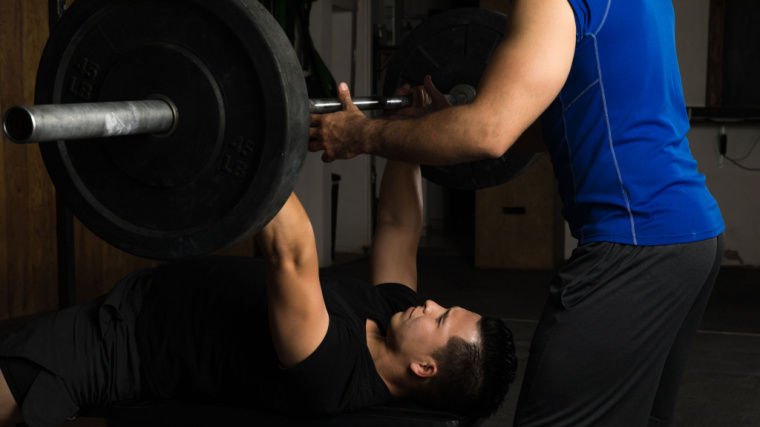“Good things come after failure. You just have to keep working.” In any other context, this statement reads as banal self-help advice. But relative to lifting, it’s sage wisdom gleaned from bodybuilders and the ever-growing science of muscle hypertrophy.
Forced reps, also known as “assisted reps,” are a popular intensification technique performed by lifters to extend an exercise set past muscular failure.(1)(2)

By forcing you to work past your limit, forced reps have the potential to unlock new muscle growth. But as with any form of advanced training, this technique must be used appropriately. Here, you will find practical and evidence-based recommendations for integrating forced reps into your lifting routine.
Guide to Forced Reps
- How Forced Reps Work
- How to Perform Forced Reps
- Physiological Effects of Forced Reps
- Who Should Perform Forced Reps
- Programming Recommendations for Forced Reps
How Forced Reps Work
Forced reps enable a lifter to perform additional repetitions past the point of muscular failure. Anecdotally, they’re among the most challenging and motivating methods of training. Better yet, there’s developing mechanistic support for their effectiveness.
To perform forced reps, you lift to momentary muscle failure and then use external assistance to immediately continue performing more repetitions. Unlike drop sets, another common intensification technique, there’s no need to strip plates off the bar, move the pin on the weight stack, or exchange your dumbbell for lighter ones.
With forced reps, your training partner simply steps in to assist you to perform the additional repetitions. Specifically, your training partner provides just enough help to allow you to grind through the “sticking point,” or most challenging portion, of the repetition.

Forced reps are thought to accelerate muscle growth via increased metabolic stress.(2) Additionally, forced reps may allow you to reap benefits from greater repetition volume, more time under load, and an intensified lifting experience.
How to Perform Forced Reps
Forced reps require the assistance of a training partner to enable the set to continue past failure. An attentive, relatively strong, and highly motivating training partner is worth their weight in gold.
Once you’ve secured a quality training partner, you must communicate before the set of forced reps begins. Discuss the exercise to be performed, how you would like your partner to assist your forced reps, when your partner should begin assisting, and how many forced reps you plan to perform past failure. Here’s exactly what you need to cover with each topic.
Exercise Selection
Non-ballistic free weight and machine-based exercises work best for forced reps. The technique can be performed with single-joint or multi-joint exercises. Among the countless exercises that could be selected, common exercises used for forced reps include pull-ups, seated overhead press, Smith machine squats, bench press, leg press, leg extensions, biceps curls, and leg curls.(3)(4)
Some exercises, however, are difficult or downright ridiculous for use with forced reps. For example, it would be very awkward for your partner to assist you in performance of forced reps for deadlifts. Even many free weight rows can be awkward to assist. Machine-based rows, landmine rows, or chest-supported T-bar rows tend are better options because they allow your partner to maintain favorable body mechanics while assisting the forced reps.
Carefully consider the exercises you select for forced reps. Obviously, each exercise should target a muscle group or movement pattern you wish to overload, but if taking a specific exercise beyond failure seems sketchy, find an alternative movement or skip it.
How Forced Reps Are Assisted
Instruct your partner to provide the minimum amount of assistance necessary to allow you to continue the set.(1)(4) The specific technique for applying assistance varies based on the lift. The technique for assisting forced reps is generally consistent with technique for spotting, though exercises not traditionally spotted will require some creativity.
Your partner should assist from the barbell during upper body barbell exercises, from the wrists during dumbbell presses, and through the torso during pull-ups, dips, squats, lunges, and step-ups. Note: assisting (and spotting) the latter two exercises is technically demanding and requires practice to perform safely.
For machine-based forced reps, technique will vary based on the exercise and equipment design. Be sure that your partner is positioned out of harm’s way and does not get their limbs or digits caught in pinch points on the machine.
When Forced Reps Are Assisted
Experienced lifters can pin-point exactly where in the repetition they will tend to “fail” during common exercises. This part of the lift is called the “sticking point.” When your repetition grinds to a halt in the sticking point, your partner will help you through it.
Inevitably, the sticking point occurs during the concentric (positive or lifting) phase of the lift. This is because muscle contractions are 20-50% stronger during the negative (eccentric or lowering phase) than during the positive.(5) Assuming fatigue affects both phases of the exercise equally, you will require assistance during the concentric phase of the exercise and little to no assistance during the eccentric.
The sticking point varies by exercise, but in general it occurs near the bottom, stretched position of presses, dips, and squats, and toward the top, contracted portion of the repetition for rows and pull-ups.
Although your partner should remain attentive to your performance through the entire repetition, you should clue them in to the specific point of the repetition they are most likely to be needed, to create a smoother and safer forced rep experience.
Determining the Number of Forced Reps
Finally, before starting your set, inform your partner how many forced repetitions you have planned.
Although you may not be able to predict the exact number of straight, unassisted repetitions you will be able to complete before failure, you must decide how many forced reps your partner will facilitate once you’ve reached failure. A skilled training partner will then fine-tune the amount of help provided to ensure you are successful yet thoroughly challenged. An unskilled training partner will shout, “Now three more,” when, in fact, you only have one more.
A discussion on programming recommendations for forced reps is provided below. But first, let’s explore the physiological demands of forced reps and determine for whom they’re best suited.
Physiological Effects of Forced Reps
As you might expect, forced reps impose considerable demand on the body and increase the need for recovery.(6)(7) They also stimulate acute changes in testosterone, growth hormone, and cortisol levels.(7)(8) This section examines the effects of forced reps and their potential significance to hypertrophy (muscle-building) and performance.
Neuromuscular and Metabolic Effects of Forced Reps
Immediately after working sets, forced reps cause greater reductions in muscle activity compared to traditional sets to muscular failure.(7) These changes have been measured experimentally via surface electromyography (sEMG). Although sEMG is not necessarily a measure of recruitment, these reductions may hint to the presence of neural fatigue as the central nervous system becomes progressively less able to stimulate motor units.(6)(7)(9)(10)

Prolonged and repeated muscle contractions occur during forced reps. Therefore, they are thought to exhaust more pools of muscle cells than traditional sets.(8) After performing forced reps, substantial fatigue occurs to the working muscle.(6) Calcium is an ion essential to muscle contraction, and its release may be impaired during fatiguing muscle contractions. (10)
Metabolites such as hydrogen, lactate, and inorganic phosphate are produced during repeated muscle contractions with minimal rest.(7)(10)(11) Although these metabolites may hasten fatigue, the metabolic stress they induce may enhance hypertrophy.(10)(11)(12)
Mechanical Effects of Forced Reps
Three related studies reported greater short-term reductions in maximum strength following forced repetitions compared to traditional sets to failure.(6)(7)(8) The earliest study compared two “leg day” workouts of squats, leg presses, and leg extensions — one used forced reps for every set and the other ended sets at muscular failure. (7)
Both workouts resulted in reductions in strength for up to 72 hours for both types of training, but forced reps caused greater reductions in strength during, immediately after, and twenty-four hours after the workout.(7) A later study showed decreased force production for the first 500 milliseconds of muscle contraction following forced reps.(6)
Altogether, these findings illustrate the effectiveness of forced reps for training fast twitch muscle fibers, which tend to have great potential for growth but prolonged recovery demands. (6)(13)
Hormonal Effects of Forced Reps
Forced reps are associated with robust anabolic hormone responses including increased serum testosterone, free testosterone, and growth hormone.(7)(8) Increased cortisol, a catabolic hormone, has also been reported following forced reps.(7)(8)
Resist the temptation infer any long-term outcomes from these findings. The relationship between acute hormone responses and desirable training outcomes (e.g. hypertrophy) remains questionable.(12)(14) Spiking certain hormones, like testosterone, briefly during or after exercise is quite different than maintaining elevated hormone levels throughout the day or week.
Who Should Perform Forced Reps
For muscle growth, the superiority of training to failure relative to not-to-failure has been questioned, both by gym rats and proverbial lab rats. (3) Forced reps take sets to the point of failure and blow right through it. To be clear, no one “needs” to perform forced reps to make gains, but it can be a useful technique to spark new muscle growth after stagnating and it can reinvigorate a stale period of training.
Although there remains a lack of research supporting most “advanced training techniques” such as forced reps, there is plenty of anecdotal and physiological support for their use.(1)(12) However, forced reps may benefit some trainees more than others.
Consider Your Training Goal
You probably associate forced reps with bodybuilding. Spoiler alert: That’s probably the best use of this training technique. Individuals training for strength or power are best served focusing prioritizing not-to-failure training.(3)(15)(16)
Interestingly, some research showed small improvements in bench press three-repetition maximum (strength) and bench press throw (power) following six weeks of forced reps. (4) Unfortunately, the forced reps strength-boosting study did not measure muscle hypertrophy.

For those looking for muscle gain, forced reps are more appealing, and there is a strong case for using forced reps for muscle gain based on volume. Resistance training volume is closely related to hypertrophy. More volume is associated with more muscle gain.(17)
While there is undoubtedly an upper limit on this relationship, a lifter will complete more total repetitions (and thereby, more total volume) using forced repetition sets than an equal number of traditional sets.
Additional volume also appears to explain the hypertrophy benefit of to-failure training compared to not-to-failure training.(18) Along the same lines, the additional volume completed past failure during forced reps may result in superior muscle gain for a lifter who would otherwise have stopped at or before failure.
Consider Your Training Status and Experience
Since beginners are extremely responsive to resistance training, it’s not necessary or prudent to program to-failure resistance training, let alone forced reps.(19)
On the other hand, intermediate and experienced trainees often require more variability in their training.(20) That is, more frequent changes in volume, intensity, and other resistance training parameters are indicated. Since forced repetitions are an intensification method that also promotes additional repetition volume, they may be appealing for more advanced lifters.
Lifters with longer training histories have been shown to experience greater androgen responses (testosterone and free testosterone) and growth hormone release than novice lifters when training with forced reps.(8) Although we must interpret these acute hormonal effects cautiously, as previously noted, it is suggested that well-trained and experienced lifters may preferentially benefit from forced reps.
Programming Recommendations for Forced Reps
Forced reps undoubtedly cause high levels of fatigue, but if you’re an advanced lifter, you’re probably thinking, “I’ve been training for umpteen years. Pfft, I can handle it.”
While advanced lifters may stand to benefit more from forced reps than beginners, research shows they also experience more profound neuromuscular fatigue following forced reps.(6) This is probably because advanced lifters are better able to tap into high threshold motor units and get more out of their sets. Basically, advanced lifters are better trained, but also better able to bury themselves under fatigue.
When fatigue outpaces recovery for too long, bad things happen. There’s the potential for non-functional overreaching, which results in non-productive training and, as a cantankerous soup vendor might say, “No gains for you.”
Even more haunting is the threat of true overtraining, which results in decreased performance even after recovery.(21) Informed programming and a well-designed approach helps to avoid these undesirable effects.
Number of Forced Repetitions
How many reps should you “force” per set? Even if you complete just one or two forced reps, you’re still doing more than a traditional set to failure. The published research protocols cited throughout this article included an average of three or four forced reps per set.(4)(6)(7)(8)
This seems like a reasonable recommendation. More forced reps result in a more intense set and, presumably, greater recovery demand. Diminishing returns can be expected as you add even more forced reps, because your training partner invariably does progressively more of the work for you. Don’t let your set of bench press forced reps become their set of barbell row forced reps.
So, for the sake of your next training session, gains, recovery, and your lifting partner, limit forced reps to five or fewer per set.
Number of Forced Rep Sets
To mitigate the risk of non-functional overreaching and overtraining, plan your forced reps sessions, and remember, there’s no need to get greedy. Previous research on forced reps compared three groups who performed short-duration training cycles of forced reps.
One group performed an average of one set of forced reps per session, another group hit an average three forced rep sets per session, and the final group completed an average of four forced rep sets per session. Remarkably, all groups improved similarly over the course of the training study.(4)
The take-home message? There does not seem to be an additive benefit to multiple sets of forced reps. An intelligent lifter might plan forced reps for only the final set of an exercise during a time-limited intensification block of training.
Frequency of Forced Rep Sets
While advanced trainees can thrive during short-term periods of high-intensity and high-frequency training, it certainly isn’t the rule.(22) Data from acute studies on forced reps suggest 48-72 hours of recovery should be allocated between workouts including forced reps.(4)(7)(8)
Don’t use the technique every day of the week. Even when targeting different body parts, the cumulative fatigue (both muscular and neuromuscular) will quickly get to be too much to recover from and your performance, and results, will suffer for it.
Training Load for Forced Rep Sets
An important consideration for forced reps is load, or training weight. How heavy should your forced rep sets be? Although they can certainly be effectively performed using very heavy loads, forced reps are best programmed using moderate loads. A general recommendation is to use your 6RM to 12RM load. That is, select a weight you’d normally lift between six and 12 times before failing.
As previously established, forced reps are best for those with hypertrophy goals. Considering that muscle growth occurs across a wide range of repetitions and loads, the use of very heavy loads unneeded.(16)(23)(24)
Moreover, assisting forced reps with very heavy loads is more technically demanding for your training partner. Extremely light loads, while easier for your training partner to handle, take more time and are likely to result in prolonged fatigue relative to heavier loads.(25)
Periodizing Forced Reps
Throwing an occasional set of forced reps into your normal routine is likely harmless and good fun. But forced reps, like other intensification techniques, are best programmed judiciously and for short, focused periods of time.
For example, you might add forced reps during the final week before a deload. Or program forced reps regularly across a four- to six-week hypertrophy training block intended to produce overreaching. In both cases, gains are made during recovery. If you’re going to train hard using forced reps, plan to recover harder with sufficient sleep, high-quality nutrition, and relative rest.
Force Gains with Forced Reps
Forced reps, or assisted reps, are a technique well-suited for intermediate and advanced lifters who want to gain muscle, have a trusted training partner, and are willing to take their recovery as seriously as their training.
References
- Hackett, D. A., & Amirthalingam, T. (2015). A brief review of forced repetitions for the promotion of muscular hypertrophy. Strength & Conditioning Journal, 37(5), 14-20.
- Schoenfeld, B. (2011). The use of specialized training techniques to maximize muscle hypertrophy. Strength & Conditioning Journal, 33(4), 60-65.
- Willardson, J. M., Norton, L., & Wilson, G. (2010). Training to failure and beyond in mainstream resistance exercise programs. Strength & Conditioning Journal, 32(3), 21-29.
- Drinkwater, E. J., et al. (2007). Increased number of forced repetitions does not enhance strength development with resistance training. The Journal of Strength & Conditioning Research, 21(3), 841-847.
- Schoenfeld, B. J., et al. (2017). Hypertrophic effects of concentric vs. eccentric muscle actions: a systematic review and meta-analysis. The Journal of Strength & Conditioning Research, 31(9), 2599-2608.
- Ahtiainen, J. P., & Häkkinen, K. (2009). Strength athletes are capable to produce greater muscle activation and neural fatigue during high-intensity resistance exercise than nonathletes. The Journal of Strength & Conditioning Research, 23(4), 1129-1134.
- Ahtiainen, J. P., Pakarinen, A., Kraemer, W. J., & Häkkinen, K. (2003). Acute hormonal and neuromuscular responses and recovery to forced vs. maximum repetitions multiple resistance exercises. International Journal of Sports Medicine, 24(06), 410-418.
- Ahtiainen, J. P., Pakarinen, A., Kraemer, W. J., & Hakkinen, K. (2004). Acute hormonal responses to heavy resistance exercise in strength athletes versus nonathletes. Canadian Journal of Applied Physiology, 29(5), 527-543.
- Vigotsky, A. D., et al. (2018). Interpreting signal amplitudes in surface electromyography studies in sport and rehabilitation sciences. Frontiers in Physiology, 985.
- Wan, J. J., Qin, Z., Wang, P. Y., Sun, Y., & Liu, X. (2017). Muscle fatigue: general understanding and treatment. Experimental & Molecular Medicine, 49(10), e384-e384.
- Goto, K. et al. (2005). The impact of metabolic stress on hormonal responses and muscular adaptations. Medicine & Science in Sports & Exercise, 37(6), 955-963.
- Schoenfeld, B., et al. (2021). Resistance training recommendations to maximize muscle hypertrophy in an athletic population: Position stand of the IUSCA. International Journal of Strength and Conditioning, 1(1), 1-30.
- Lievens, E., et al. (2020). Muscle fiber typology substantially influences time to recover from high-intensity exercise. Journal of Applied Physiology, 128(3), 648-659.
- Schoenfeld, B. J. (2013). Postexercise hypertrophic adaptations: a reexamination of the hormone hypothesis and its applicability to resistance training program design. The Journal of Strength & Conditioning Research, 27(6), 1720-1730.
- Izquierdo, M., et al. (2006). Differential effects of strength training leading to failure versus not to failure on hormonal responses, strength, and muscle power gains. Journal of Applied Physiology, 100(5), 1647-1656.
- Pareja‐Blanco, F., et al. (2017). Effects of velocity loss during resistance training on athletic performance, strength gains and muscle adaptations. Scandinavian Journal of Medicine & Science in Sports, 27(7), 724-735.
- Schoenfeld, B. J., Ogborn, D., & Krieger, J. W. (2017). Dose-response relationship between weekly resistance training volume and increases in muscle mass: A systematic review and meta-analysis. Journal of Sports Sciences, 35(11), 1073-1082.
- Vieira, A. F., et al. (2021). Effects of resistance training performed to failure or not to failure on muscle strength, hypertrophy, and power output: a systematic review with meta-analysis. The Journal of Strength & Conditioning Research, 35(4), 1165-1175.
- Lasevicius, T., et al. (2022). Muscle failure promotes greater muscle hypertrophy in low-load but not in high-load resistance training. Journal of Strength and Conditioning Research, 36(2), 346-351.
- DeWeese, B. H., Hornsby, G., Stone, M., & Stone, M. H. (2015). The training process: Planning for strength–power training in track and field. Part 1: Theoretical aspects. Journal of sport and health science, 4(4), 308-317.
- Bell, L., et al. (2020). Overreaching and overtraining in strength sports and resistance training: A scoping review. Journal of Sports Sciences, 38(16), 1897-1912.
- Zourdos, M. C., et al. (2016). Efficacy of daily one-repetition maximum training in well-trained powerlifters and weightlifters: a case series. Nutricion Hospitalaria, 33(2), 437-443.
- Lasevicius, T., et al. (2018). Effects of different intensities of resistance training with equated volume load on muscle strength and hypertrophy. European Journal of Sport Science, 18(6), 772-780.
- Schoenfeld, B. J., et al. (2021). Loading recommendations for muscle strength, hypertrophy, and local endurance: a re-examination of the repetition continuum. Sports, 9(2), 32.
- Haun, C. T., et al. (2017). Molecular, neuromuscular, and recovery responses to light versus heavy resistance exercise in young men. Physiological Reports, 5(18), e13457.
Featured Image: UfaBizPhoto / Shutterstock
The post Forced Reps — What They Are and How to Use Them appeared first on Breaking Muscle.

0 Comments